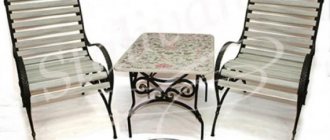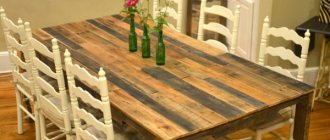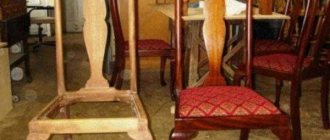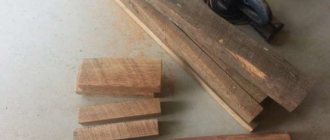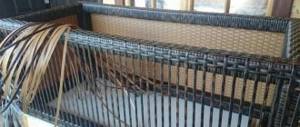The workshop is looking for permanent employment as a furniture maker. Shellac finishing training.
The workshop repairs and restores chairs made of wood, metal, leather, and upholstered chairs. as well as carved, antique, Soviet, modern. Braided, bent. Viennese, designer and so on.
Gluing a rickety chair, restoring threads, extending legs, strengthening the back - carpentry work. Refresh or renew the varnish, restore the color, perform manual polishing, including with shellac - the job of a finisher. An upholsterer, as they called it in the old days, a draper, knows how to remake a seat from sea grass and re-stretch the springs.
The cost of restoration includes all consumables.
Estimate the cost of restoration work from a photograph, call a restorer, get advice from a specialist.
It is important for the customer that the chair after restoration is comfortable, the color that was ordered, does not wobble, and is neatly upholstered with fabric. What the restorer will do is, by and large, not very interesting to the customer. But why different workshops quote different prices for the same type of work—repairing or re-gluing chairs—raises questions.
Firstly, low prices may be due to the fact that the workshop only carries out minor repairs. Demanding from such a performer complex actions, such as the color that is needed, and not the one that turned out, is simply not realistic. By the way, it is the color and quality of finishing of the wooden parts of the chair that account for the lion's share of complaints.
Secondly, the prices indicated are not for the full scope of work, but are broken down by operation. Let’s say it’s only for gluing, and the upholstery comes in a separate column. Well, the most common trick when specifying low prices is that during the restoration process hidden defects are “discovered”, for which the customer will certainly have to pay extra.
Before you give your chairs and money for repairs to strangers, look at the finished work of the master and be sure to clarify what exactly will be included in the price specified in the contract.
How much does it cost to restore a wooden chair?
Depending on the damage, prices for chair restoration are divided into three categories.
Minor chair repairs
– strengthening the frame with slight looseness. Re-gluing the chair, replacing the fabric, partially restoring the varnish. 3-5 thousand rubles.
Complete restoration of a chair
– Dismantling, cleaning the chair from dirt, darkened varnish, damaged glue, restoring threads, parts connecting parts, extending legs. Replacing the filling, upholstering with fabric or leather, decorating with carnations or braid. 10 – 15 thousand
Restoration of antique chairs.
They are more expensive not because they are antique, but because they have more damage and the technology is more complex. Most often, antique chairs from the 19th century, stored for a long time in unfavorable conditions. In the country house, attic, disassembled on the mezzanine. The carving has been partially lost, the gilding has been worn off, and the varnish has worn down to the wood.
The table shows the optimal prices for the repair and restoration of chairs with the most common types of damage.
| Chair | Minor repairs | Complete restoration with re-gluing and varnish replacement | Restoration from a ruined state |
| Hard wooden chair | 3-5 t.r. | 10-15t.r. | from 15 t.r. |
| Soft chair or floor chair | 5-7 t.r. | 10-17t.r. | from 20 t.r. |
| Antique spring chair with sea grass and horsehair | 10-15 t.r. | 20-25t.r. | Dog. |
| Empire style, classicism, shellac polished | 30-35 t.r. |
The photo shows simple living room chairs after restoration. 1. Chair with rattan mesh seat. 2.Chair with a semi-soft seat. Replacing fabric. 3. Chair with bent plywood back. 4. Soviet chair from the 60s.
These things may not be of historical value, but they are very cute and comfortable. A touching memory of a happy and carefree childhood.
In the workshop you can also order chairs to be painted in the color of the table, extend chair legs, or simply change the fabric. Restore a unique historical item with a high degree of damage.
How to update furniture?
Remaking old furniture
Chair repair
Cost of painting wood furniture
Our specialization is the scientific restoration of highly artistic furniture with a critical degree of destruction. Thanks to the use of authentic materials and work using ancient technologies, the chairs after our restoration retain their historical authenticity and can be fully used.
When repairing wooden furniture, regardless of whether it is old or new, the technologies for restoring wood are almost the same
Photos 1 and 2 show ways to extend a chair leg. Photos 3 and 4 show the gluing of the back of the chair. In both cases, the gluing area is reinforced with wooden dowels. After tinting and finishing with varnish, they are almost invisible, but it is the presence of reinforcement that provides a long-term guarantee for our work.
How to update an old chair? Pre-cleaning
First, the surface of the chair must be cleaned of the old coating,
whatever it may be. If there is soft seat upholstery, it must first be removed. You don’t necessarily need “male strength” to do this. Try turning the chair upside down and you will see that the seat is attached with screws that need to be removed. To do this, you need to arm yourself with a hammer (for knocking out the seat) and a screwdriver (straight or Phillips).
Now you can start removing the old coating. To do this, you can use regular sandpaper of different grain sizes or a sanding sponge. It is important to sand the surface of the wood well. This will help you easily apply the coating you choose later. It is worth saying right away that this work is not easy.
But it is possible to simplify the process a little by periodically moistening the surface to be treated. This way you can get rid of dust. Just don’t be alarmed by the fact that moisture makes the old varnish viscous. This is fine. After the chair has completely dried, you need to sand the entire surface well again with fine sandpaper.
Why are old chairs restored?
When antiques, chairs from the 19th and 18th centuries, are restored, this is understandable. Antiques, preserving Russian culture, investing money, luxury goods and so on. Soviet chairs from the 50s and 60s seem to have no need to be repaired. It's cheaper to buy new ones. But it's not cheaper. Anyone who has ever tried to buy good wooden chairs in modern stores knows how difficult it is to find a comfortable, beautiful, real chair. I'm talking about real, wooden ones, suitable in design, size, color and quality of upholstery.
At best, such a chair will cost 15-20 thousand rubles. Luxury restoration of a chair from the 50s and 60s is no more expensive with us.
Modern chairs or copies of time-tested models: Thonet, Chipendale, Classicism, second Rococo. Or the fantasies of modern designers. The lifespan of modern products is determined by the shelf life of the materials used. Foam rubber, glue, plastic fasteners. Machine production allows for a certain amount of defects. Cross-layered, economical gluing, inexpensive fabrics. Hence their fragility. Why buy expensive if it will break in a year or two anyway.
Old chairs are reliable friends. We survived renovations, moves, flooding of neighbors from above, weddings and student parties. If they get a little dirty, or the upholstery is worn out, then restoring them is not that expensive.
When buying wooden chairs, choose hardwoods such as oak or beech. Birch is a relatively soft tree. Chairs made from it do not last long.
How to update an old chair? Everything is in order
Now it all depends on your imagination.
If you decide to varnish the surface of the chair, you need to use a colorless primer so that the texture of the wood is clearly visible through the protective layer. A layer of primer will have to be used in any case. Even if you decide to paint the chair in the future.
The fact is that paint adheres better and lasts longer if the surface is first primed. The surface must be coated with varnish in two layers. It is important that the first coat is thoroughly dry before applying the second. The varnish can be applied with a brush or by spraying it over the surface.
The chair can be painted any color.
Nowadays white furniture is considered very fashionable. And the seat upholstery can be contrasting. Nowadays there are many ways to show originality. For example, use a stencil. Let it be flowers or any other ornament.
Another way to cover the surface of a chair is with beeswax balm.
The surface is also pre-sanded and primed with drying oil. Then cover with a thin layer of balm using a cloth. After twelve hours, the surface is polished with a brush.
Now you can begin restoring the upholstery
. The old one needs to be removed. Previously, it was attached to the seat using ordinary nails. You will also have to get rid of the foam rubber. It is necessary to cut a new one according to the old standards. The fabric must be cut with a margin for hemming. The material for upholstery can be very different: either a special fabric for upholstered furniture, or regular linen or thick cotton. It is better to fasten the fabric with a furniture stapler. But if you don't have one, don't worry. You can use regular nails by hammering them in. It is important to remember that the material must be well stretched on all sides.
Now the seat can be inserted into its original place and fastened with screws.
How much does it cost to paint a chair?
There are two types of painting. Professional and artisanal. Handicraft does not mean bad, but original. There is an effect of surprise. You never know what they'll get. If you call it handicraft, with drips and unpainted marks, it’s original or designer, the prices rise significantly.
We do professional painting. It turns out exactly what you ordered. It needs to be smooth, it will be smooth. If you need it with an aging effect, preserving the wood texture or patina, you will also get exactly what you ordered.
Painting a wooden chair with suitable paint costs from 2 to 3 thousand rubles. To paint with the effect of French enamel - about 5 thousand rubles.
In order for the varnish or paint to lay evenly, first the surface is thoroughly sanded. Then it is covered with a primer layer. Liquid varnish can be used as a primer. Next, the pile is removed. Painting turns out smoother if it is done not in one dense layer, but in 2-3 liquid ones, with intermediate drying and sanding of each layer.
If the last layer of painting is done with a transparent colorless varnish, the finish will look more expensive, and the paint layer will become stronger.
Paint an already varnished chair. There are two ways. The first is simple, applicable to completely new furniture. The old finish is used as primer. We sand the entire surface, level it, and paint it. If the chair has already been used and is slightly dirty, the old varnish or paint will have to be cleaned more thoroughly.
Paint an old chair. Everything is the same as in the previous case, plus repair and strengthening of the frame, alignment or extension of the legs, re-gluing of all parts. Elimination of minor surface damage in the form of stains, dirt, scratches, potholes. Replacement of seat filling, upholstery with tapestry, leather, upholstery fabric, finishing with nails or braid... Hand finishing with a special one that emphasizes the natural color and texture of the wood. This will be called restoration of a chair; the cost of the work will be determined by the degree of destruction of the thing itself. Experience shows that such a service will cost at least 15,000 rubles, but no more.
One day a completely collapsed chair was brought into the workshop, complete with five legs. They poured everything out of the bag and asked to choose from what was available what was suitable.
When restoration is carried out, the cost depends on the time required to complete the work. A paradox arises here. The higher the qualification of the master and the better organized the work in the workshop, the lower the cost of the service. And, therefore, in the fight for the client, the workshop can afford to either reduce the price for simple repairs, or provide an exclusive service of higher quality, but at the price of regular repairs, at the average prices accepted in Moscow.
Minor chair repairs
. Essentially, this is something between routine repairs and furniture care. In the old days, furniture reupholstery was taught at the Institute of Noble Maidens. Each housewife of high origin, in addition to knowing several languages, playing the piano, and the ability to conduct small talk, possessed the wisdom of running a household, altering dresses (remember Anna Karenina), pickling mushrooms, knitting collars, sewing sofa bolsters, pillows, and reupholstering ottomans.
Seat reupholstery price
, more precisely, replacing fabric, a semi-soft chair with replacing the filling with natural materials from 1,000 to 3,000 rubles Coconut fiber, wool or cotton batting. The cost of the seat filler does not affect the price of the restoration. Nowadays foam rubber is not much cheaper than natural flooring materials.
Cost of complete restoration
wooden chair. Determined by the scope of work. It begins with removing dirt, sometimes along with old, destroyed, blackened varnish.
Next is disassembly. The operation is necessary. The old glue is destroyed and will only hinder a new reliable gluing. Therefore, so that after repair the chair does not become loose again within a year, it is necessary to remove all the old glue and build up the shrunken spines. Fit exactly and glue securely.
The tenon joints of wooden chairs dry out over time. The spikes begin to fit loosely in the grooves. There is a backlash. Hence the looseness of the chairs. To ensure that the chair never wobbles again, the tenons are built up with wood so that they fit tightly in the grooves. Next, the chair is assembled “dry” without glue. The diagonals between the legs are measured, if the legs are of different lengths, they are increased. After this, the chair is disassembled and glued together with wood glue. It is better to use a mixture of flesh glue and bone glue. Bone gives strength, and flesh gives some elasticity. Adding oils, drying oils, and antiseptics to high-quality natural glue according to ancient recipes is unnecessary.
If the chair was previously glued with PVA, STOLYAR, KLEIBERIT glue or something else based on polyvinyl acetate emulsion, the glue must be cleaned with special care, otherwise the glue will not be durable. A fresh solution will not be able to penetrate the wood fibers, and the gluing will be temporary.
We reinforce the seat drawer in the corners with “kerchiefs” or “crumbs”. After assembly, the chair is tinted with water-based stain to give the desired shade, or remains in its natural color. Finished by hand with clear varnish. All together from 15,000 to 25,000 rubles.
These are the maximum prices to date for high-quality professional restoration carried out according to the canons of scientific restoration. Thanks to strict quality control, we can provide our customers with virtually unlimited warranty periods.
Our specialization is the restoration of complex, artistic, antique, antique furniture with a high degree of damage. Carved wooden and Empire “noble” chairs require a special type of polishing. Soft spring seagrass seats and Viennese wicker furniture call for authentic materials. Modern designer or high-quality Italian and English chairs made of solid wood, gilded, painted, decorated with paintings force one to master new technologies for decorating modern luxury furniture. Over the decades of the workshop's existence, everything that was restored, repaired, reupholstered, painted, polished remained with the master restorers in the form of experience.
We treat Soviet chairs made in the 50s and 60s with special tenderness and sympathy. This is our story, childhood memories. As a rule, USSR chairs have reached us in relatively good condition.
Method 4. Decoupage a chair with fabric
It would seem that there is no other way to radically modify a chair with your own hands other than by painting. In fact, there is another cool way - decoupage with fabric.
- A chair updated in this way will last a surprisingly long time, even under heavy loads. And if individual threads come out of the fabric along the edges of the chair, you can simply cut them off and treat them with a layer of PVA glue.
Decoupage idea for an old chair
You will need:
- Textile;
- Wooden chair;
- PVA glue or special glue for decoupage;
- A sharp stationery or breadboard knife;
- Brush for applying glue.
How to update a chair using decoupage technique:
Step 1. Using a screwdriver, remove the back and seat from the chair. If you want to paint the chair, do it before taking it apart.
Step 2. Spread the fabric on a flat surface, place the seat on it and trace it along the contour, stepping back about 2.5 cm from the edge, then cut out the blank.
Step 3: Cover the outside of your seat with PVA glue, then lay the fabric over it and smooth it out. Once the fabric is straight, coat it with PVA glue and leave to dry overnight.
Step 4: Once the fabric is dry, make sure it is completely stiff. Next, trim the excess fabric with a sharp knife exactly along the edges of the seat.
Step 5: Now coat the perimeter of the seat with PVA glue again to prevent wear around the edges.
Step 6: Repeat steps 2-5 with the chair back and other parts you want to decorate and finally put the chair back together. The main condition for successful restoration of a chair is that the pattern must accurately repeat the shape of the surface being decorated.
Here are some more photo ideas for decorating a chair with fabric.
Decoupage of an office chair with fabric with additional protection with polyurethane varnish
Stool decoupage ideas
Time passes, and even good things wear out, lose their former luster and simply break. But don’t rush to send a worn stool to the landfill; it can still become a stylish and functional piece of furniture. Restoring a chair will take a lot of time and effort, but the result will exceed all expectations.
Before deciding how to restore an old chair with your own hands, you need to take care of its stability. With prolonged use, the furniture becomes loose: the wood dries out, and the glued tenon joints cease to perform their function.
A stunning effect can be achieved by simply painting the chairs in different colors.
Carpentry work
- First, the node connection is disassembled. Be careful not to damage it. The spike is swung and at the same time the knot is tapped with a hammer.
- The groove area is cleaned of old glue and dust. It is convenient to do this with a chisel or knife.
- Then the spike and socket are evenly and thinly coated with glue with a viscosity of 200.
- Afterwards the assembly is assembled and clamped in clamps. The product must be in the clamping device for at least three hours. The remaining dispersion is removed with a damp cloth.
Important! If a bolted connection needs repair, place metal or plastic washers under the nuts and tighten the nuts.
- If the wooden elements are not adjacent to the eyes, you can increase the missing volume with a thin piece of wood. Use casein or flesh glue. The adhesive is left pressed for 8-10 hours in a warm room. Professional craftsmen use a belt tie, which allows them to achieve the required force when gluing.
- If a tenon breaks, it is better to replace the defective part with a new one. The leg is processed with a hacksaw and the nest is cut out with a chisel to a depth of 50 mm. Afterwards, cut out the insert of the required size and hammer it in with a hammer.
Advice. Use PVA dispersion, it is non-toxic and not prone to destruction. Epoxy adhesive “Master” or “EDP” will also work.
The legs can be securely fixed using wooden scarves. You will also need studs with nuts and washers.
Removing old coating
To get rid of the old coating, use sandpaper. It is not necessary to remove absolutely the entire top; it is important to create a smooth and even surface. Restoring chairs yourself will not seem too exhausting if you use a sander.
Advice. You can remove the varnish with technical acetone. They moisten a napkin with it and wipe the product well. At the same time, the natural color of the wood remains.
A grinding machine will speed up the process of removing the old layer.
Finish: painting and varnishing
Since wood absorbs liquid quite well, you need to prime the surface before finishing, this will reduce material consumption. A colorless primer is suitable if the wood will only be coated with varnish. Otherwise, choose a white primer. Chairs in white or black look great with contrasting upholstery.
Important! Before work, put on a respirator and gloves.
- Apply 1-2 coats of primer. When the chair is dry, go over it with fine-grained sandpaper.
- Now use wax balm, it will give the surface a special shine. Then polish everything with a brush.
- Paint the chair twice. The second layer is applied to a dry surface.
- Apply a thin layer of varnish along the grain of the wood.
Advice. Use water-based paint, it is easy to apply and dries quickly. You will also need a stencil if you want to decorate the chair with an original design.
Polishing and painting is best done outdoors.
Removing and reupholstering the seat
You will need: a furniture stapler, staples, a screwdriver with bits, foam rubber 5 cm thick (or two pieces 2-3 cm thick), thick fabric for the backing and upholstery fabric for the top. Filling for seats can be padding polyester, batting, or foam rubber.
- First remove the seat and upholstery. Do not throw away the solid wood base.
- Turn the chair over and remove all the fasteners that hold the seat in place. Remove the factory staples.
- Pull out the frame with the spring. Free it from any remaining filler.
- Cut a rectangle from thick fabric to the size of the seat; cut out the upholstery with a margin. The allowance should be 6-8 cm.
- Place a thick fabric backing on the spring. Use a furniture stapler to attach the fabric to the frame.
- Place a layer of filler on top. The optimal thickness for the seat is 4-5 cm.
- Then install the upholstery material; it is most convenient to do this with an assistant. The upholstery can be special textile material, as well as linen and leather.
The fabric at the corners can be fixed in this way
